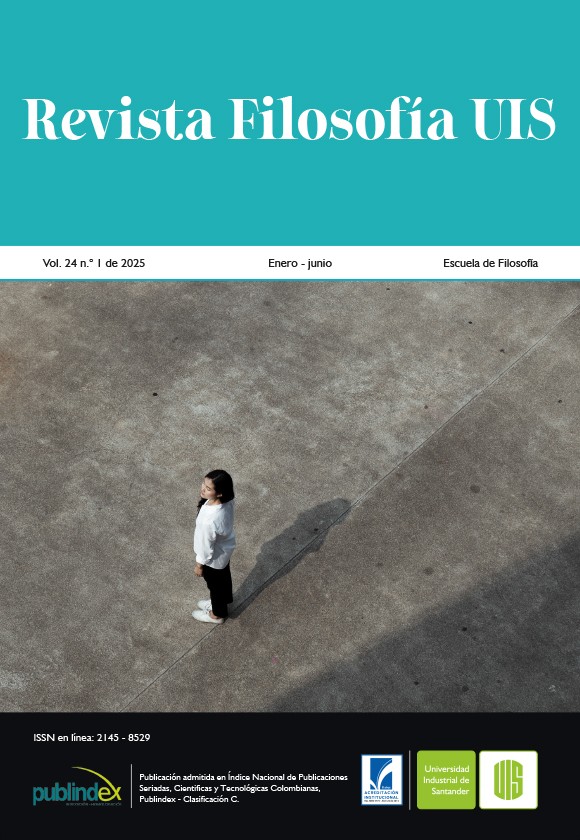Positivity and Negativity: A Comparison Between Byung Chul Han and René Girard
Published 2025-01-22
Keywords
- violence,
- desire,
- René Girard,
- Byung Chul Han,
- modernity
How to Cite
Copyright (c) 2025 Revista Filosofía UIS

This work is licensed under a Creative Commons Attribution 4.0 International License.
Abstract
The article proposes a comparison between the perspectives of René Girard and Byung Chul Han on violence, in order to understand the contemporary dynamics of the subject. Girard analyzes violence as a result of mimetic desire, while Han relates it to the desire to assert the self in capitalist society. Girard, in works such as Deceit, desire and the novel and Violence and the Sacred, expounds the theory of triangular desire and the scapegoat as the origin of culture. On the other hand, Han, in Topology of Violence, argues that violence arises from the desire for self-affirmation and constant production of the self in the capitalist context. Although they start from different premises, both criticize modernity and its promises of autonomy. Girard points out how imitation leads to melancholy, while Han exposes the depression of the self-exploiting subject. In addition, transcendence and immanence are discussed in contemporary society, where the sacred is diluted or disappears. Both negative and positive perspectives of desire offer a profound understanding of current social and psychological dynamics.
Downloads
References
- Almeyda, J. (2022). Prácticas de la amabilidad: una interpretación del pensamiento de Byung-Chul Han. Areté, 34(2), 291-318. https://doi.org/10.18800/arete.202202.001
- Antonelli, M. (2014). Sobre el origen del concepto de “Inmanencia” en Gilles Deleuze. Revista Internacional Interdisciplinar INTERthesis. Revista Internacional Interdisciplinar, 11(2) 15-36. https://doi.org/10.5007/1807-1384.2014v11n2p15
- Antonello, P., y Webb, H. (2010). Mimesis, Desire, and the Novel: Rene Girard and Literary Criticism. Michigan State University Press.
- Castro Rocha, J. (2017). ¿Culturas shakespearianas?: Teoría mimética y América Latina. ITESO.
- Deleuze, G., y Guattari, F. (1985). El anti Edipo capitalismo y esquizofrenia. Ediciones Paidós.
- Di Battista, M. (2010). Jealousy and Novelistic Knowledge. En H. Webb y P. Antonello (eds.), Mimesis, Desire, and the Novel: Rene Girard and Literary Criticism (pp. 3-16). Michigan State University Press.
- Escamilla González, J. M. (2013). Dios ha muerto Lo hemos matado, el saber sobre los sacrificios en la exposición girardiana de la teoría mimética [Tesis de licenciatura en filosofía, Universidad Panamericana].
- Girard, R. (1985). Mentira romántica y verdad novelesca (J. Jordá, trad.). Editorial Anagrama.
- Girard, R. (1996). The Girard Reader. En J. G. Williams (Ed.). Crossroad Herder.
- Girard, R. (1999). Literature and Christianity: A Personal View. Philosophy and Literature, 23(1), 32-43. https://doi.org/10.1353/phl.1999.0017
- Girard, R. (2005). La violencia y lo sagrado (J. Jordá, trad.). Anagrama.
- Girard, R. (2010). Clausewitz en los extremos (L. Padilla López, trad.). Katz Editores.
- Han, B. (2012). La Sociedad del cansancio (A. Saratxaga Arregi, trad.). Herder Editorial.
- Han, B. (2016). Topología de la violencia (P. Kuffer, trad.) Herder Editorial.
- Hegel, G. W. F. (2010). Fenomenología del espíritu (A. Gómez Ramos, trad.). UAM ediciones, Abada editores.
- May, T. (2005). Gilles Deleuze: An Introduction. Cambridge University Press.
- Mendoza Álvarez, C. (2017). Sobre la invisibilización del otro. Una recepción latinoamericana de Levinas y Girard. En C. Mendoza-Álvarez., J., Jobim., y M. Méndez Gallardo (Eds.), Mímesis e invisibilización social: la interdividualidad colectiva latinoamericana. Editorial Universidad Iberoamericana.
- Sanabria Galvis, G. (2022a). Contar historias nos salvará del apocalipsis: una interpretación de cien años de soledad desde la teoría mimética. [Tesis de maestría, Pontificia Universidad Javeriana] https://repository.javeriana.edu.co/handle/10554/61022
- Sanabria Galvis, G. (2022b). Revolución y conversión: observaciones girardianas sobre Cien años de soledad. Revista Interdisciplinar De Teoría Mimética. Xiphias Gladius, (5), 99–110. https://doi.org/10.32466/eufv-xg.2022.5.730.99-110
- Schmidt, L. (2018). Paradigmas del ser humano: aproximación al camino a la complejidad. Revista Educación Y Desarrollo Social, 11(2), 108–130. https://doi.org/10.18359/reds.3245
- Vinolo, S. (2010). Ipseidad y alteridad en la teoría del deseo mimético de René Girard: la identidad como diferencia. Universitas Philosophica, 27(55), 17-39. https://revistas.javeriana.edu.co/index.php/vniphilosophica/article/view/11044

